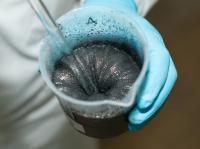Shear Thickening Fluids – liquid intelligence
A fluid as hard as a stone? Yes, that is possible. Non-Newtonian fluids are a well-known phenomenon but how to use their properties to our best advantage? Ask the team from the Chair of Chemical Engineering at the Faculty of Chemistry from the Warsaw University of Technology.
What is actually a shear thickening fluid? “This is a non-Newtonian fluid whose viscosity rapidly increases with the rate of shear strain”, explains Prof. Mikołaj Szafran who is the Head of the Chair of Chemical Engineering.
What this means in practice: an object immersed in that kind of fluid will easily go down. However, if the same object were to be immersed very rapidly, the fluid would immediately start becoming solid and resist the object.
It is these properties that Prof. Mikołaj Szafran’s team decided to exploit.
Magic or chemistry?
Shear thickening fluids (STF) are usually composed of hard particles of metal oxides involving silica, corundum, kaolin etc. existing in liquid chemical compounds. Although shear thickening fluids are significantly less common in industry than shear thinning fluids, they still attract more and more interest every year.
The properties of such fluids can be controlled in order to change the shear rate at which shear-dependent viscosity increases. It is essential to control such fluids when we want to exploit their properties for practical purposes. The team of scientists from the Warsaw University of Technology also developed a method of producing such fluids which is a very tricky issue as their properties are quite an obstacle in the process of obtaining them. Our scientists patented that method.
A flexible armour
Prof. Szafran’s team have been working with shear thickening fluids for as long as 7 years. These substances can be used in protective vests or armours which should not limit their users’ movements. But should anybody try to injure a wearer with a knife, the fluid in the vest will become solid and absorb the energy of the stab.
Thanks to this knowledge and in cooperation with Prof. Marcin Leonowicz’s team from the Faculty of Materials Science and Engineering, the scientists from the Faculty of Chemistry at the Warsaw University of Technology developed a shear thickening fluid used in bullet-proof vests. This innovative bullet-proof vest filling received an award in the 2015 Focus Lenses poll. The project implemented thanks to the cooperation of scientists from the Warsaw University of Technology, Military Institute of Armament Technology and the Institute of Safety Technology Moratex in Łódź was voted the most innovative invention of the past year by internauts.
Comfort and safety
Shear thickening liquids are also applied in football pads. The project “Energy-absorbing intelligent materials protecting the human body” finished in February 2016. As a result, WUT scientists developed a prototype of football pads filled with a non-Newtonian fluid.
The ability to control the parameters of a fluid and bring them in line with the assumptions of a project has resulted in the development of high-quality liquid pads protecting footballers’ shinbones. Such pads will be manufactured by the company “Polsport”. The idea behind this was to develop a new generation of football shin pads which would be flexible and able to adjust to the shape of the leg”, explains Prof. Szafran.
These pads will be flexible and footballers will find them comfortable to use but they will also protect them from the consequences of being attacked by a member of the opposing team. “Pain should be felt by the one who is kicking and not the one who is being kicked”, says the Professor, laughing.
Research to be continued
The knowledge of these materials is developed at the Faculty of Chemistry and the Faculty of Materials Science and Engineering (there are a number of theses on the subject). These materials can be applied in many situations requiring flexibility in normal use but rapid hardening in an emergency, eg. an imminent threat of injury.
Where else might the properties of shear thickening fluids be exploited? As a filling in helmets, insoles, shock-absorbing skis, biker pads or even in buildings exposed to seismic risk.
Monika Bukowska
Office for Promotion and Information








